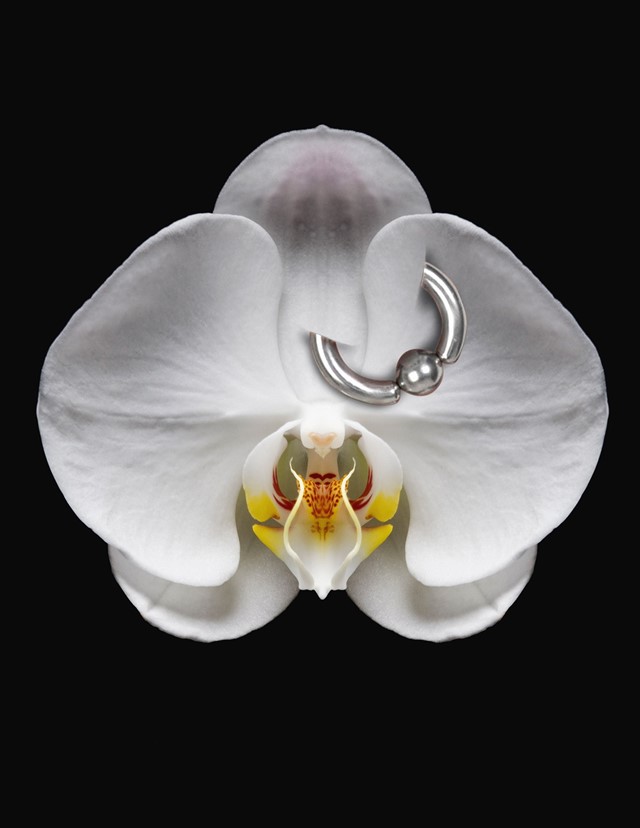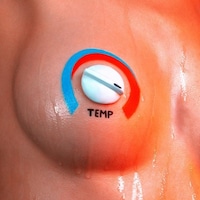Many trans people find a profound sense of healing through ‘genital biohacking’ with piercings that is difficult to find through other means
If the phrase ‘genital biohacking’ incites visions of sex robots or a naked Gwyneth Paltrow in her laboratory, it’s not your fault. A quick Google search reveals results that are, at best, weird and, at worst, stuff Edward Scissorhands would find hard to swallow. In reality, biohacking covers any DIY practice done for biological performance or health enhancement, including modifying your genitals with piercings.
This isn’t just “a new weird thing young people are doing”, Lynn Loheide, a non-binary professional piercer and ‘body modification historian’ tells Dazed. Genital biohacking “can range from simply getting genital piercings and modifications, to taking hormones to change the size, shape and function of our genitals to create anatomy that better suits our purposes”.
People have been getting their junk pierced for diverse reasons – aesthetic pleasure, enhanced sexual sensation, spiritual and self-expression, body reclamation, novelty, kink and taboo – for centuries. Intimate piercings were discovered on mummified remains of the Dayak tribe from Borneo dating back to 2000 BC and even recommended for their sensual benefits in the Kama Sutra. But recently, rising numbers of trans and gender non-conforming people are modifying their genitals with piercings for one reason: identity and gender affirmation.
Anatomical specifics, like tissue shape, size, width and length, and developments like bottom growth and bottom shrinkage, are essential to the gender-affirming potential of these piercings, but rarely cited outside a piercing studio or doctor’s office. For many trans people, a genital piercing is a proud marker of successful transitioning and achieving the gender and anatomy they’ve always identified with. For others, the aesthetic or physicality of a piercing can mimic the appearance or sensation of anatomy they’ve always wanted to have.
At 18 years old, Loheide boldly went where few had been before: they pierced their own vertical clitoral hood. “It was an extremely empowering and healing experience for me. In 2020 I finally came to terms with my gender identity after years of struggle and began transitioning. I realised how much piercings and body modification were the things that helped me come to terms with my gender identity.”
Loheide gets regular feedback from their online following and in-person clients about the immediate influence piercings can have on gender dysphoria. A lot of clients choose piercings to give their genitals a more masculine or feminine aesthetic in keeping with how they identify and, Loheide adds, “to accentuate the parts of their anatomy that they do enjoy, or to distract from the parts of their anatomy that may cause dysphoria”.
Intimate piercings are known to be sensation-enhancing, but their unique physical interaction with genitalia can do more than improve sexual satisfaction. “For people seeking gender-affirming relief, these piercings can do things like stretch genital tissue, for example the clitoris, to a large enough gauge and diameter that they can feel the weight of them,” Tobias, a genderfluid piercing apprentice, tells Dazed. “They can provide the sensation of having the genitals they feel most aligned with.”
Tobias began hormone therapy a year before getting their first of seven intimate piercings in 2020. They plan to use multiple piercings to replicate a frenum ladder to create the appearance of male genitalia. “The only way I can describe it,” says Tobias, “is that seeing the piercings on myself makes my body look more natural than it did without.”
Intimate piercings have the potential to confront binary thinking and challenge long-standing beliefs that gender exists and is anatomically defined. “What I’ve loved most about collecting genital piercings is that my genitals feel outside of the ‘traditional’ binary,” says Loheide. “Body mods have helped my anatomy take on an aesthetic that doesn’t feel gendered – it’s something outside the spectrum of traditional gender norms.”
“I want someone to look at my genitals and be slightly shocked,” Basilica, a Nashville-based trans-masculine non-binary piercer, tells Dazed. They want to create anatomy that is neither male nor female, but “biomechanical”. All their piercings have captive bead rings that are chunky and heavy, an ornamental choice that adds to the “biomechanical” character, but also comes with an added bonus: “I have to walk differently to keep things from pinching or getting caught, which has given me a stereotypically ‘masculine’ gait.”
Many trans people, including Loheide, find a profound sense of healing through genital biohacking with piercings that are difficult to find elsewhere. This is more than catharsis – especially in a world where health services still make the trans community wait years for life-saving care. “I am a survivor of childhood sexual assault and have struggled with trauma and insecurities surrounding my genitals since then. Living with that sort of trauma… my body always felt ‘wrong,’” Loheide says. “Getting that piercing allowed me to reclaim my body.”
Most people utilising genital biohacking in their personal lives do so in ways, and for reasons, that are safe, liberating and life-affirming. Despite body modification and gender-affirming practices’ slow expansion into the mainstream, stigma and misunderstanding linger. Piercers like Loheide are doing socially radical work to remedy a systemic deficit. If healthcare systems worldwide had sufficient gender-affirming care, practices like genital biohacking and intimate piercings could be less about saving lives, and more about exploring humanity’s individuality, beauty, sensuality and innate fluidity.
Join Dazed Club and be part of our world! You get exclusive access to events, parties, festivals and our editors, as well as a free subscription to Dazed for a year. Join for £5/month today.




